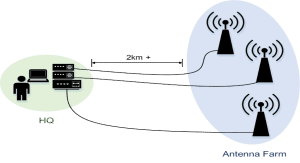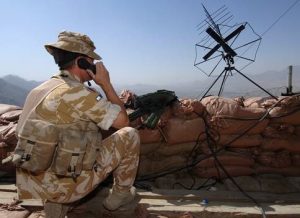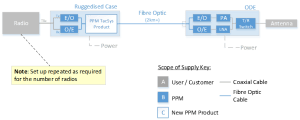RF Over Fibre (RFoF) Real Time Applications: Part 2 – Remoted antennae for tactical signal management
Author: Andy Haslam, Director of Business Development, PPM Systems
“IF YOU EMIT ON THE BATTLEFIELD YOU WILL BE TARGETED”
In my previous article Signature Management to improve survivability on the battlefield I explained that the old adage of transmit and move within 8 minutes to avoid being targeted has now become measured in seconds.
On a battlefield it is almost impossible to reduce RF transmissions to zero and prosecute the battle ‘in the dark’. Instead tactical use of ground, situation and capability has to be used to deceive the enemy as to intent and positioning of assets thus improving survivability, both human and physical. This is costly in terms of manpower and the defensive measures required to protect the HQ.
One way to achieve this is to move the emitters (what the enemy can see electronically) away from the assets to improve survivability from delivery of a kinetic attack, >300m away. These distances cannot be achieved by using co-axial links, nor can they use network solutions for obvious reasons as explained in my previous article, The role of RFoF in Defence Applications.
Remoting the emitters away from the people also enables a deception plan to be put in place, deceiving the enemy as to your true location and confusing the Recognised Electro-Magnetic Picture (REMP) that they are building of your capability and positioning. Through ultra-fast switching, several emitter sites can be utilised. This will not prevent those sites becoming targeted, and future antennae will need to become more of a commodity, but it will slow the enemy down in its direction finding (DF) and ability in locating.
A proven low risk method to remote antennae is to use Optical Fibre. This is known COTS technology and is in use now within the commercial SATCOM industry, to provide long distance links many hundreds of kilometres long, with minimal loss of signal integrity and fidelity and has been proven to increase detection range by a factor of 5 and transmit power by a factor of 7 when compared to co-ax. This alone may increase the usability BCIP and other nations Comms systems.
The use of RF over Fibre (RFoF) for a tactical deployment therefore reduces the amplification of the transmit signal and the number of REBRO stations required. All of this combined therefore will reduce the ability of the enemy to build their REMP of your deployment.

Figure 1 – Antenna remoting concept that improves survivability
Concept Solution Overview
Most tactical communication radio systems are Transceivers (TRx), in that both the antenna and radio equipment can ether Transmit (Tx) or Receive (Rx) signals. Although there are numerous ways a TRx system can operate, it is often managed through a Tx / Rx (T/R) switch controlled by a keyline from the radio equipment. This keyline is not always available as an external connector on the radios, necessitating a radio redesign to access it); or, it is available in varying formats on a radio-by-radio basis, limiting the commonality / flexibility of solutions dependent on it.
PPM has therefore developed a solution that does not rely on a keyline so is radio agnostic; this enables its usage across any radio system, maximising flexibility and supporting Land Open Standards Architecture (LOSA). An illustrative High Level Diagram (HLD) for this solution is shown below, noting that it would be scaled depending on the number of radio systems and antennas as required.
Figure 2 – Illustrative HLD for PPM’s radio agnostic antenna remoting concept solution
The equipment at the radio equipment end uses COTS and proven Electro-Optic (EO) conversion products to convert the RF signal from the electrical to optical domain for Tx and from optical to electrical domains for Rx. The EO converters are in a TRx card format where both the Tx and Rx EO conversion is delivered in a single card.
Using Tx as an example, once the signal is in the optical domain, it can be transported over substantial distances of up to ~30 km with almost negligible losses without any amplification (or longer distances with amplification). PPM’s new TacSys product enables the TRx capability by providing an automated T/R switching functionality; it sends command signals to the T/R switch at the antenna along the same fibre cable as the tactical communications.
At the antenna end, there is a ruggedised enclosure for each antenna that houses the equivalent EO converter to the radio equipment end to convert the signals to or from the optical domain for Rx or Tx signals respectively. The T/R switch and relevant RF conditioning including Power Amplifier (PA) and Low Noise Amplifier (LNA) for the Tx and Rx paths respectively are included in this housing.
Benefits of RFoF signal distribution and remoted antennae
- Tactical use of Ground
- People and high value assets separate from high risk areas for kinetic attack
- 5x Receive range increase when compared to co-ax
- 7x Transmit unamplified power increase when compared to co-ax
- Quick and easy to deploy, re-deploy and collapse as required
- No Key line requirement
- Hardware agnostic
- Supports LOSA – LCA / CMOSS
- Optimum antenna placement for effect– not restricted by the ground suitable for a HQ deployment
 An additional benefit of this approach means that an ANY – ANY (Hub Star) technology can be employed, agnostic at either end so any TRx to any Ae, this is especially valid where shared resources are to be used, coupled with a secure by design data distribution system meaning that signals of interest can be routed to specific sections within a HQ, at varying security classifications to get the right signals to the right people at the right time. Reducing cognitive burden and providing Any Signal Anywhere.
An additional benefit of this approach means that an ANY – ANY (Hub Star) technology can be employed, agnostic at either end so any TRx to any Ae, this is especially valid where shared resources are to be used, coupled with a secure by design data distribution system meaning that signals of interest can be routed to specific sections within a HQ, at varying security classifications to get the right signals to the right people at the right time. Reducing cognitive burden and providing Any Signal Anywhere.
Look out for my next series of articles which will focus on the Maritime domain and the unique challenges of conducting CEMA / EMSO at sea, both surface and sub-service.

